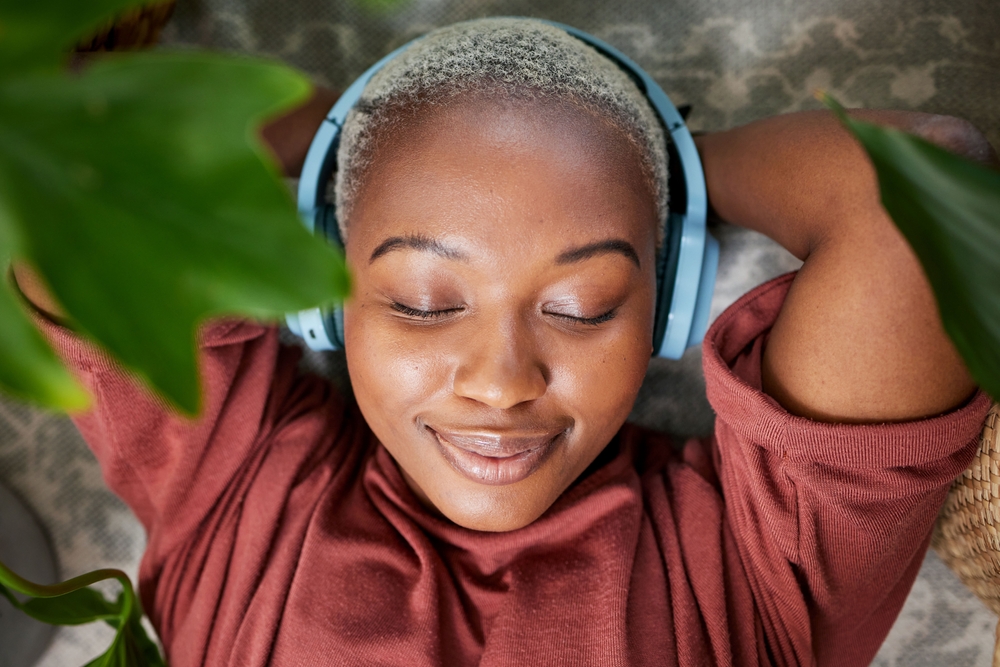Sound therapy is generating a lot of buzz on social media. But so are the misconceptions surrounding it. Here’s the lowdown on how it actually works.
It’s pretty safe to assume most of us are looking for ways to alleviate stress, sharpen our focus and get better sleep. While the idea of using noise to achieve these goals might seem counterintuitive, many people swear by swaddling themselves in a blanket of sound for better quality of rest, concentration, and less anxiety.
With origins that can be traced back to diverse, ancient African cultures, the concept of sound healing therapy is far from new. Primeval societies on the continent used sound rituals as a way to communicate with the divine and the ancestors, their use of instruments such as drums, kalimbas, koras and mbiras playing a key role in ceremonial restoration and remedy. In the past 60 years, however, the attraction to this inherent wisdom has led to a resurgence of its therapeutic, traditional sounds. And as the world continues to search for and embrace holistic approaches to good health, the internet and social media communities have revived the practice as a vital source of healing for certain physical and mental health conditions today.
While many of us are familiar with the calming effects of white noise, the countless testimonies to other versions like pink, brown and green sound therapy are also booming, especially on TikTok. But as the claims of these varying, ambient “hues” continue to become a widely accessible, life-changing treatment option (they come with undeniable implications of how they effectively quiet other noises that can keep people from having a healthy quality of life), so are the growing misunderstandings that encompass it.
The belief that sound healing therapy is a new-age trend, a cure-all for illnesses or can be classified as nothing more than satisfying, background noise are only a few of many commonly believed myths about the practice, those that lend themselves to uninformed skepticism and distrust. But the truth is, the treatment is quite complex. Although low-frequency sounds and meditation music have a long track record for being helpful in improving negative mental states of depression, anxiety, influencing physiological health factors, even aiding in the treatment of cancer cells, the research on how they exactly work continues to surface.
Ahead, the latest in sound healing therapy and its benefits.
@divineharmoniesmusic Immerse yourself in the soothing world of White Noise. Can you focus for a minute? 🧘♂️ See the difference! Don't forget to check my bio for a curated meditation playlist. 🎧 #WhiteNoise #Mindfulness #Meditation #Focus #BreathingExercises #Noise #HealingSounds #StressRelief #SleepAid #SoundTherapy #TikTokMeditation ♬ White noise(1181478) – Y8MD
To improve concentration and focus, listen to white noise.
The combination of different frequencies, or more commonly, that slightly static-like sound from a TV caught between channels or an empty radio station, white noise can help mask the sounds that may keep people from becoming distracted. Experts say that due to how our cochlea (inner ear) hears high-pitched sounds, the soothing, blank noise could be of help to those who might need to pivot their attention.
While the high-frequency broadband sound isn’t for everyone (some find it’s too hissy), there is evidence it may help individuals with Attention-Deficit Hyperactivity Disorder (ADHD). A 2019 study examining the neural circuitry of adults (it helps us to carry out certain tasks when activated) found that when white noise is played at low volumes, it could significantly enhance learning, as compared to those who work in silence. With this in mind, researchers say that if the theory of stochastic resonance holds merit (it suggests that the presence of white noise helps to boost original sounds and signals), then it might help individuals to focus on other outside influences and learn more quickly.
However, it is important to note that doctors warn about the use of white noise as a soothing solution for children, regardless of their neurodevelopmental state. While studies show how it proves highly effective in enhancing brain states for learning in adults, some neuroscientists warn how it can actually be harmful to kids as it can hinder auditory learning. It also might impede the development of the auditory system in infants.
In the end, while it’s possible that white noise can help avoid those peeving thoughts that keep you from a task (a.k.a. internal stimuli) and tune out some of life’s inescapable background noise (big-city dwellers know this better than anyone), most neurologists and researchers have yet to fully claim it as a certified solution.
@divineharmoniesmusic Immerse yourself in the calming world of Brown Noise. Enhance focus, enjoy deep sleep, and mask distractions. Listen for 60 seconds and feel the difference. 🎧🌟 #BrownNoise #Meditation #Focus #BreathingExercises #SleepAid #NoiseTherapy #StressRelief #Mindfulness #Wellbeing #SelfCare #tiktokwellness #noise ♬ Brown noise – Pure Brown Noise – Power of Noise
If you need to relax, try listening to brown noise.
Named after the scientific term Brownian motion (the random movement of small particles in a fluid), brown noise is perhaps the most popular of the “colored” sounds right now. To date, there hasn’t been much formal research about its benefits, but many theories exist on how it effectively settles the mind.
Brown noise has a lower frequency than white, so it sounds less “staticky.” And although substantiated, clinical support doesn’t yet exist, it is showing auditory masking outcomes, which means it could have the ability to cover up or disguise off-putting sounds within your earshot, making it a more favorable option to use long term. It also shows promise as a worthy alternative to background “elevator” music.
@divineharmoniesmusic Experience the calming power of Pink Noise. Perfect for focus, relaxation, and deep sleep. 🎧😴🎯 #PinkNoise #Meditation #Focus #BreathingExercises #NoiseTherapy #Relaxation #DeepSleep #Mindfulness #Wellness #StressRelief #soundhealing ♬ Pink Noises – White Noise Sleep
To fall asleep, try pink noise.
For those white noise enthusiasts who desire a little less hiss, the lower-frequency sounds of pink noise could work well. Although it is a bit louder than white noise (many compare it to the sound of rainfall), studies have shown it can gradually slow brain waves that allow the body and brain to enter a state of rest and restoration. Experts in the field also note that pink noise filters out jarring noises that jolt you out of sleep, like a car horn honking, a door slamming or someone snoring.
@calm Ready to drift off to the most relaxing sound in the world? #GreenNoise ♬ Green Noise with River – Calm
To make studying or working easier, listen to green noise.
Another pleasing substitute to white noise (it has less of a fizzle), the sound of green noise can create a sense of being in a peaceful outdoor environment, such as water flowing, songs of birds or the sounds of waves on the beach. It promotes a calming effect on the mind and body and helps to alleviate tension.
@mindscapes_asmr Blue Noise #soothing #soothingsounds #asmr #relax #ataraxia #mentalhealth #fyp #foryou #foryoupage #musictherapy #sleep #bluenoise ♬ original sound – Kpax Ataraxia – Mindscapes_ASMR
And the noise you should ditch altogether…blue noise.
While the other sounds are mainly classified as pleasurable to the brain and body, blue (or purple) noise is often compared to that of a wheezing water sound, which could be quite annoying. It’s mostly utilized by sound engineers in digital audio production, called “dithering”, the process of adding a small amount of random noise to a signal in order to reduce unwanted sound distortion.








